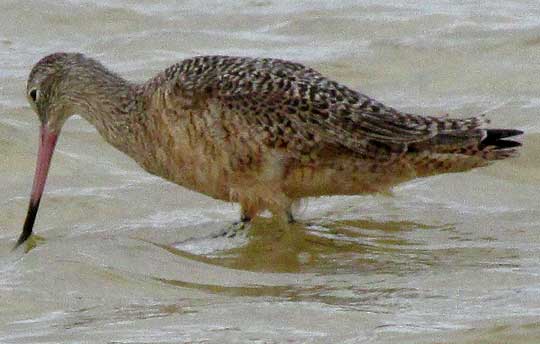Excerpts from Jim Conrad's
Naturalist Newsletter

from the November 2, 2014 Newsletter issued from Río Lagartos, on the Yucatan Peninsula's northern coast (~N21.60°, ~W88.16°), Yucatán state, MÉXICO
MARBLED GODWITS
These days out in the estuary in front of Río Lagartos wherever the water is shallow enough, large, mostly mixed flocks of wading birds spend their time probing the submerged mud with their beaks. The birds sort themselves out very neatly according to this principle: The deeper the water, the larger the bird and the longer the legs. For example, above you can see two fair-sized Marbled Godwits, LIMOSA FEDOA, working into the wind as they systematically probe mud beneath about two inches of water.
Behind the godwits, in shallower water, smaller Short-billed Dowitchers do the same work with their shorter beaks. A closer look at a godwit is provided below:

The way the various species sort themselves out according to water depth is only part of the story. Each large, mixed flock in a feeding area is much more than a random, congenial gathering of individuals wandering about picking up snacks here and there. They're finely tuned communal operations configured so that each individual and species gets all the food-energy it can while expending as little of its body's stored energy as possible. And all this in the context of avoiding predation by various enemies, dealing with social status among its own species, and taking the future into consideration.
For example, in a 2009 paper in the journal "Waterbirds," José Castillo-Guerrero and others found that during their non-breeding wintering season in western Mexico, Marbled Godwits changed their feeding behavior as the season progressed. The percentage of the birds' time devoted to vigilance dropped from 8–23% in October and November to 0.4–8% in February and March. Also, during that same period, time devoted to feeding jumped from only 12–40% to 59–74%. The authors supposed that these changes reflected the birds' change in priorities as the season progressed. Early in the season, merely surviving was most important, so they were very watchful. Later in the season it became more important to feed and accumulate energy stored as fat, in preparation for migrating back north to breed in the spring. The authors concluded that " ... habitat choice by specific individuals was complex and probably involved condition- or state-dependent tradeoffs that balanced metabolic requirements, safety priorities, and, perhaps, social status or dominance." The abstract of this study is freely available at http://www.bioone.org/doi/abs/10.1675/063.032.0304?journalCode=cowa.
Once it's realized that what at first looks like a big picnic of gypsy-like birds is actually a gathering of individuals and species engaging in a life-or-death competition for extremely limited resources, even as they have to deal with enemies who want to eat them, higher ranked individuals who might take a jab at them, and with preparations for the eventual exhausting and dangerous journey back north, the way we see our birds changes. In fact noticing how the belly feathers of the godwit in our last picture are so disordered and waterlogged, how the bird is in a water depth exactly matching the top of its legs, and noticing the somehow grim-looking expression on the bird's face as the entire head is about to be thrust below the water so that the beak can be stabbed blindly again and again into mud... one can almost feel sorry for that bird.